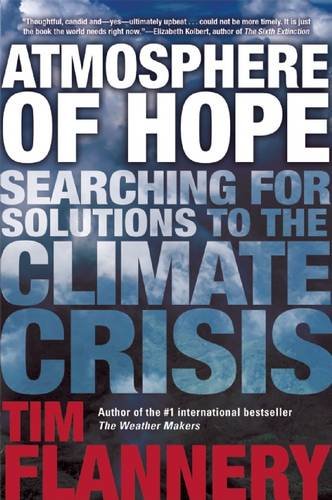

| ATMOSPHERE OF HOPE Searching for Solutions to the Climate Crisis Tim Flannery New York: Atlantic Monthly Press, October 2015 |
Rating: 5.0 High |
|||
| ISBN-13 978-0-8021-2406-7 | ||||
| ISBN-10 0-8021-2406-2 | 245pp. | HC/GSI | $27.00 | |
In 2005, Tim Flannery released The Weather Makers. It was named Book of the Year at the 2006 New South Wales Premier's Literary Awards.
As the years have gone by, the predictions he made in that book have come true, and then some. The pace of climate change has been accelerating — sea levels rising faster, arctic ice cap diminishing more, glaciers melting faster than science had predicted. Storms are getting stronger, wildland fires are burning more acres, droughts are lasting longer. It is clear that we are being harmed by the effects of climate change now; the harm is not something relegated to distant Pacific islands or far-off decades.
"When Al Gore released An Inconvenient Truth and I published The Weather Makers a decade ago, climate change was thought of as a hypothetical issue by most people. You had to understand complex graphs and computer models to grasp it. As of 2014 most people have experienced enough extreme and record-breaking weather to know that climate change is not only real but threatening to their health, livelihoods and security. Across the U.S., for example, average temperatures have risen by up to 1°C, and Americans know from bitter experience that with the rising average come savage extremes. In the next few decades temperatures across the U.S. would rise by half a degree Celsius even if all global emissions of greenhouse gases had stopped immediately in late 2014. We are late—very late indeed—in acting to secure our future." – Page X |
This is not to say human civilization faces imminent danger of collapse. Changes great enough to bring that about still belong to the remote future. But that future grows less remote the longer we delay significant actions. Tim Flannery's latest book aims to show us some of the ways we might take action.
Nor is the lack of action as pervasive as it often appears. While the United States and a few other governments have persistently been throwing up roadblocks to mitigation measures, many nations have established firm commitments to reducing greenhouse-gas emissions. Meanwhile a great deal of action has been taking place on regional, state, and local levels. And individuals have been making their own contributions: installing solar arrays, driving electric cars, insulating their homes. Here, Dr. Flannery reprises the story and brings it up to date, looking into some promising new ideas.
The United States of America remains one of the few obstinate obstacles to concerted action against climate change. Australia is another, both at the federal and state levels. Queensland may be the most obstinate of its states. Dr. Flannery relates that:
"This book describes in plain terms our climate predicament, but it also brings news of exciting tools in the making that could help us avoid a climate disaster." – Page IX |
Most everyone agrees now that the climate is changing. Almost as many agree that this is causing problems. The ways to address these problems fall into three categories:
Dr. Flannery devotes the last section of his book to these methods, concentrating on remediation, which he calls "the third way." He discusses a number of interesting possibilities, never going into great detail because these are fledgling technologies, and because there are so many to discuss. It is an excellent overview, imparting a genuine sense of hope — albeit a tenuous one. That sense of hope would grow much firmer if some national governments were not so dead set on stomping it out.
Dr. Flannery is deeply involved in fostering the sense of hope and, focusing primarily on the Australian national and state governments, he goes over the history of climate denialism since The Weather Makers was published in 2005. Also, in the five chapters of Part One, he summarizes the harmful effects we expect to come with climate change — many of which are coming faster than expected.
Part Two of the book is devoted to effects of climate change that we currently see — larger and more frequent forest fires (and a longer fire season), cloudbursts and flooding more common, etc. — and to the conventional methods of combating them, such as sea walls. These methods include geoengineering, which has received extensive theoretical development. Part Two also discusses the outlook for fossil fuels and nuclear power. A highlight here is Chapter 9, which gives an admirably cogent summary of the problems with fracking (although he misses the problem of methane leakage.) There are more problems than I was aware of. He quotes Jeremy Leggett:
"We have learned that the top 15 players in US shale drilling have written off $35 billion since the boom started, and that investors are beginning to pull out. Meanwhile, production has peaked and is beginning to fall off in all but one of the major shale-gas drilling regions. The boom is looking like it could turn into a bust before too long." – Jeremy Leggett, Page 103 |
Dr. Flannery's latest book includes a list of organizations fighting for a better climate. It has extensive endnotes and a good index. It is definitely worth reading. It probably is not a keeper, though, but more likely one you'll want to pass along to a friend, or donate to a local library, as a thought-provoker. Like the author's earlier books, it succeeds admirably at that.

 To contact Chris Winter, send email to this address.
To contact Chris Winter, send email to this address.